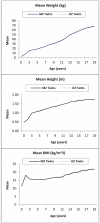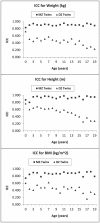Genetic and environmental contributions to weight, height, and BMI from birth to 19 years of age: an international study of over 12,000 twin pairs
- PMID: 22347368
- PMCID: PMC3275599
- DOI: 10.1371/journal.pone.0030153
Genetic and environmental contributions to weight, height, and BMI from birth to 19 years of age: an international study of over 12,000 twin pairs
Abstract
Objective: To examine the genetic and environmental influences on variances in weight, height, and BMI, from birth through 19 years of age, in boys and girls from three continents.
Design and settings: Cross-sectional twin study. Data obtained from a total of 23 twin birth-cohorts from four countries: Canada, Sweden, Denmark, and Australia. Participants were Monozygotic (MZ) and dizygotic (DZ) (same- and opposite-sex) twin pairs with data available for both height and weight at a given age, from birth through 19 years of age. Approximately 24,036 children were included in the analyses.
Results: Heritability for body weight, height, and BMI was low at birth (between 6.4 and 8.7% for boys, and between 4.8 and 7.9% for girls) but increased over time, accounting for close to half or more of the variance in body weight and BMI after 5 months of age in both sexes. Common environmental influences on all body measures were high at birth (between 74.1-85.9% in all measures for boys, and between 74.2 and 87.3% in all measures for girls) and markedly reduced over time. For body height, the effect of the common environment remained significant for a longer period during early childhood (up through 12 years of age). Sex-limitation of genetic and shared environmental effects was observed.
Conclusion: Genetics appear to play an increasingly important role in explaining the variation in weight, height, and BMI from early childhood to late adolescence, particularly in boys. Common environmental factors exert their strongest and most independent influence specifically in pre-adolescent years and more significantly in girls. These findings emphasize the need to target family and social environmental interventions in early childhood years, especially for females. As gene-environment correlation and interaction is likely, it is also necessary to identify the genetic variants that may predispose individuals to obesity.
Conflict of interest statement
Figures





Similar articles
-
Genetic and Environmental Effects on Weight, Height, and BMI Under 18 Years in a Chinese Population-Based Twin Sample.Twin Res Hum Genet. 2015 Oct;18(5):571-80. doi: 10.1017/thg.2015.63. Twin Res Hum Genet. 2015. PMID: 26379063
-
[Genetic and environmental contributions to body mass index in a Spanish adolescent twin sample].Med Clin (Barc). 2015 Aug 21;145(4):153-9. doi: 10.1016/j.medcli.2014.05.039. Epub 2014 Jul 24. Med Clin (Barc). 2015. PMID: 25066500 Spanish.
-
Genetic and environmental effects on body mass index from infancy to the onset of adulthood: an individual-based pooled analysis of 45 twin cohorts participating in the COllaborative project of Development of Anthropometrical measures in Twins (CODATwins) study.Am J Clin Nutr. 2016 Aug;104(2):371-9. doi: 10.3945/ajcn.116.130252. Epub 2016 Jul 13. Am J Clin Nutr. 2016. PMID: 27413137 Free PMC article.
-
Twin's Birth-Order Differences in Height and Body Mass Index From Birth to Old Age: A Pooled Study of 26 Twin Cohorts Participating in the CODATwins Project.Twin Res Hum Genet. 2016 Apr;19(2):112-24. doi: 10.1017/thg.2016.11. Twin Res Hum Genet. 2016. PMID: 26996222 Free PMC article.
-
Nutrition, Other Environmental Influences, and Genetics in the Determination of Human Stature.Annu Rev Nutr. 2024 Aug;44(1):205-229. doi: 10.1146/annurev-nutr-061121-091112. Epub 2024 Aug 12. Annu Rev Nutr. 2024. PMID: 38759081 Review.
Cited by
-
Interventions for lifestyle changes to promote weight reduction, a randomized controlled trial in primary health care.BMC Res Notes. 2013 May 27;6:213. doi: 10.1186/1756-0500-6-213. BMC Res Notes. 2013. PMID: 23711165 Free PMC article. Clinical Trial.
-
Modeling gene-environment interactions in longitudinal family studies: a comparison of methods and their application to the association between the IGF pathway and childhood obesity.BMC Med Genet. 2019 Jan 11;20(1):9. doi: 10.1186/s12881-018-0739-x. BMC Med Genet. 2019. PMID: 30634949 Free PMC article.
-
Your height affects your health: genetic determinants and health-related outcomes in Taiwan.BMC Med. 2022 Jul 13;20(1):250. doi: 10.1186/s12916-022-02450-w. BMC Med. 2022. PMID: 35831902 Free PMC article.
-
Factors Associated with Reaching Mid-Parental Height in Patients Diagnosed with Inflammatory Bowel Disease in Childhood and Adolescent Period.Gut Liver. 2024 Jan 15;18(1):106-115. doi: 10.5009/gnl220421. Epub 2023 Aug 28. Gut Liver. 2024. PMID: 37638380 Free PMC article.
-
Left ventricular mass is underestimated in overweight children because of incorrect body size variable chosen for normalization.PLoS One. 2019 May 29;14(5):e0217637. doi: 10.1371/journal.pone.0217637. eCollection 2019. PLoS One. 2019. PMID: 31141818 Free PMC article.
References
-
- Lobstein T, Baur L, Uauy R IASO International Obesity TaskForce. Obesity in children and young people: A crisis in public health. Obes Rev. 2004;5(Suppl 1):4–104. - PubMed
-
- World Health Organization (WHO). Obesity and overweight: Fact sheet [no 311]. 2006. Accessed: 2010 April 19.
-
- Johannsson E, Arngrimsson SA, Thorsdottir I, Sveinsson T. Tracking of overweight from early childhood to adolescence in cohorts born 1988 and 1994: Overweight in a high birth weight population. Int J Obes (Lond) 2006;30(8):1265–1271. - PubMed
Publication types
MeSH terms
LinkOut - more resources
Full Text Sources
Medical
Research Materials

